Class 10 FRANK Solutions Biology Chapter 9 - Nervous System
Practise Frank Solutions for ICSE Class 10 Biology Chapter 9 Nervous System to prepare well for your ICSE board exam. Understand terms such as a neuroglial cell, cranial nerve, hormonal system, hypermetropia etc. with our Biology solutions. Learn the labelling of diagrams that explain the longitudinal section of the human brain, the vertical section of the mammalian brain, the structure of the human ear and the vertical section of the human eye.
Also, revise the various parts of the nervous system with our Biology learning materials like practice tests, concept videos, solved question papers etc. TopperLearning’s ICSE Class 10 Biology revision materials are created by experienced teachers according to the latest ICSE Class 10 Biology syllabus and exam guidelines. You can use these resources to prepare for the board examination and to secure top marks in Biology.
Nervous System Exercise 115
Solution 1
(ii) Autonomic Nervous System
(iii) Conus medullaris / Medullary cone
(iv) Mixed neurons
(v) Neuroscience
(vi) Sensory neurons
(vii) Motor neurons
(viii) White matter
(ix) White matter
(x) Dura mater
(xi) Neuron
(xii) Meninges
(xiii) Cranium
(xiv) Neocortex / Neopallium
(xv) Limbic system
(xvi) Corpora quadrigemina
(xvii) Olfactory Lobes
(xviii) Median fissure
(xix) Agraphia
(xx) Brain
(xxi) Aphasia
(xxii) Trigeminal nerve
(xxiii) Sympathetic nervous system
(xxiv) Dendrites
(xxv) Bipolar neuron
(xxvi) Sclera
(xxvii) Myopia
(xxviii) Semicircular canal
(xxix) Rhodopsin
Nervous System Exercise 116
Solution 5
(ii) Axon - It is a fibre like process of the neuron which carries impulses away from the cell body.
(iii) Cyton - It is an oval, angular, polygonal or stellate body which contains a large central nucleus.
(iv) Action potential - A momentary change in electrical potential on the surface of a cell, or a nerve or muscle cell, that occurs when it is stimulated, resulting in the transmission of an electrical impulse.
(v) Reflex action - It is an immediate and involuntary response to a stimulus.
(vi) Yellow spot - It is the region of best vision where more cone cells are present.
(vii) Blind spot - It is the region of no image formation because of lack of cone cells.
(viii) Power of accommodation - It is the ability of the lens to focus on far and distant objects.
Solution 6

Solution 7
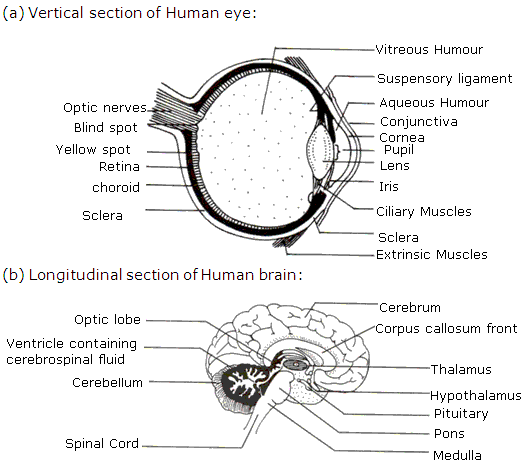
Solution 3
(ii) Blind spot
(iii) Myelin
(iv) Olfactory lobe
(v) Cranial nerve
Solution 4

Exercise
Solution
Solution
Nervous System Exercise 117
Solution 8

Solution 9
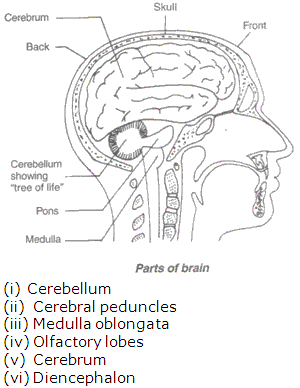
Nervous System Exercise 118
Solution 20
Cerebrum: cytons are present outside and axons are inside
Spinal cord: cytons are present inside and axons are outside.
Solution 21
(i) It controls the involuntary activities like - respiration, circulation, digestion, etc.
(ii) It controls the dilation and constriction of blood vessels.
Solution 22
Example - 1. Blinking of eyelids on exposure to light .
2. Knee jerk.
Solution 11
(ii) Ganglia - It is located outside the brain and spinal cord.
(iii) Cerebellum - It is located behind cerebrum and above medulla oblongata in the brain.
(iv) Nodes of Ranvier - It is located on the unmyelinated areas on the axon.
(v) Effector organs - It is located in muscle , gland or any organ of the body.
Solution 12
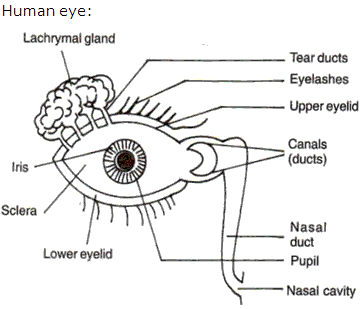
Solution 13

Solution 14
(ii) Semicircular canals: It is located in the inner ear. These are concerned with the body equilibrium.
Solution 15
(i) Removing hand suddenly when pricked by a thorn.
(ii) Blinking of eyelids on exposure to light.
Solution 16
(ii) Example of a conditioned reflex: Tying one's shoe lace.
Solution 17
(b) Inner ear
(c) Eardrum
(d) Bone of skull
(e) Bone of middle ear
(f) Middle ear
(g) Air filled
(ii) (b) Inner ear - It transmits the impulse to brain.
(d) Bone of skull - It helps in fixing the position of the ears to help the brain use auditory cues to judge direction and distance of sounds.
(g) Air filled - It keeps the pressure in the middle ear equalized with pressure in the outside.
(iii) The main division of the ear are: outer ear, middle ear and inner ear.
(iv) Stirrup
(v) The labyrinth is the inner ear which consists of utriculus, sacculus, cochlea and three semicircular canals.
Solution 18
B - Utriculus
C - Sacculus
D - Cochlea
(ii) Auditory nerve.
(iii) 1. Utriculus and sacculus
2. Semi-circular canal
3. Cochlea
(iv) Sensory cells of organ of Corti
(v) Perilymph
Solution 19
(ii) Fovea centralis - It is a point at retina where more cone cells are concentrated and thus produces sharpest vision.
(iii) Three semicircular canals - It maintains the dynamic equilibrium.
(iv) Retina - It prevents the reflection of light.
(v) Lachrymal glands - It produces tear to lubricate the eyeball.
Nervous System Exercise 119
Solution 23
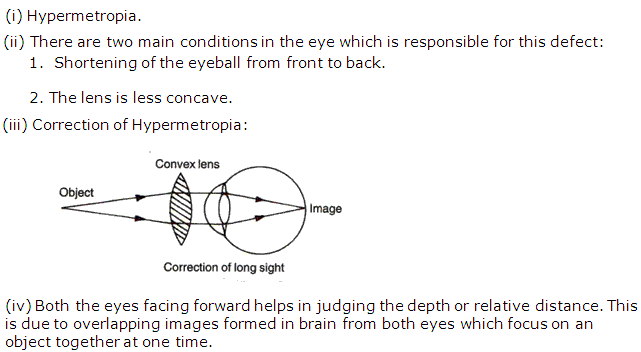
Solution 24
Solution 25
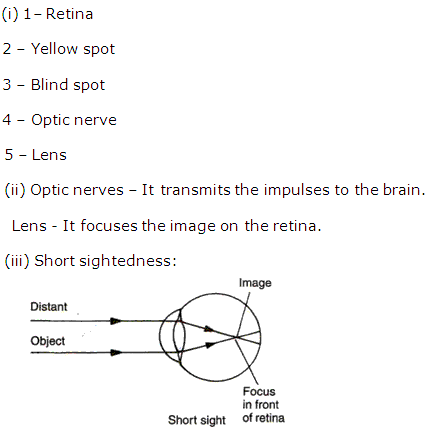
Solution 26
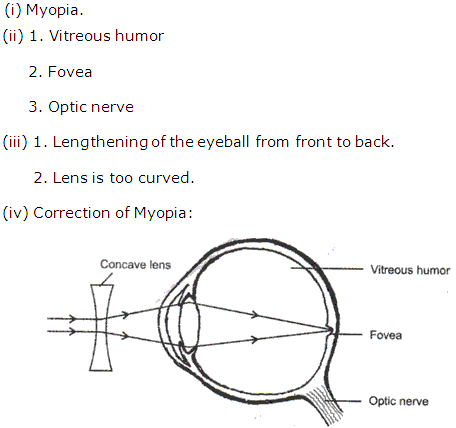
Solution 27
(ii) Meninges: It provides protection to brain and spinal cord.
Solution 28
Solution 29
(ii) Cerebrospinal fluid
Solution 30
(ii) True
(iii) True
(iv) True
(v) False
(vi) True
(vii) False
(viii) False
Nervous System Exercise 120
Solution 31
(ii) (b) cerebrum
(iii) (a) 31
(iv) (b) 12
(v) (a) dura mater
(vi) (a) ear
(vii) (c) rhodopsin
(viii) (a) twilight vision
(ix) (d) macula
(x) (d) two nerves
(xi) (c) hearing
(xii) (b) 31
(xiii) (a) eustachian
(xiv) (c) iris
(xv) (b) cones
(xvi) (b) Ear
(xvii) (d) corpus callosum
(xviii) (d) eye
(xix) (d) filter light
(xx) (b) the two cerebral hemispheres

